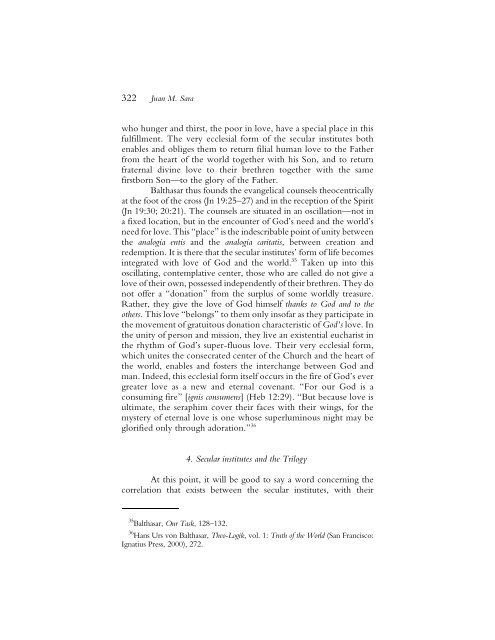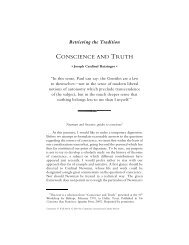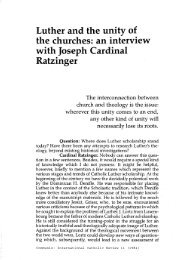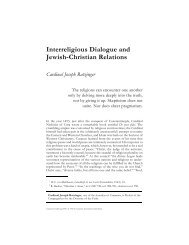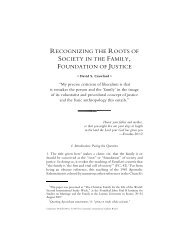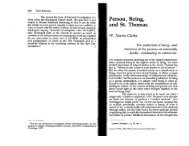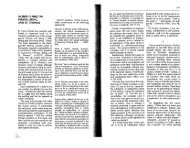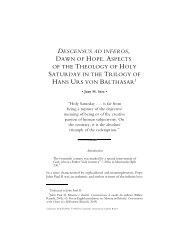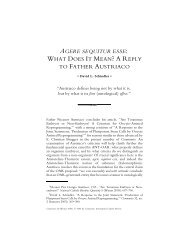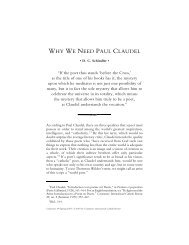Juan Sara. Secular Institutes According to Hans Urs ... - Communio
Juan Sara. Secular Institutes According to Hans Urs ... - Communio
Juan Sara. Secular Institutes According to Hans Urs ... - Communio
Create successful ePaper yourself
Turn your PDF publications into a flip-book with our unique Google optimized e-Paper software.
322 <strong>Juan</strong> M. <strong>Sara</strong><br />
who hunger and thirst, the poor in love, have a special place in this<br />
fulfillment. The very ecclesial form of the secular institutes both<br />
enables and obliges them <strong>to</strong> return filial human love <strong>to</strong> the Father<br />
from the heart of the world <strong>to</strong>gether with his Son, and <strong>to</strong> return<br />
fraternal divine love <strong>to</strong> their brethren <strong>to</strong>gether with the same<br />
firstborn Son—<strong>to</strong> the glory of the Father.<br />
Balthasar thus founds the evangelical counsels theocentrically<br />
at the foot of the cross (Jn 19:25–27) and in the reception of the Spirit<br />
(Jn 19:30; 20:21). The counsels are situated in an oscillation—not in<br />
a fixed location, but in the encounter of God’s need and the world’s<br />
need for love. This “place” is the indescribable point of unity between<br />
the analogia entis and the analogia caritatis, between creation and<br />
redemption. It is there that the secular institutes’ form of life becomes<br />
integrated with love of God and the world. 35 Taken up in<strong>to</strong> this<br />
oscillating, contemplative center, those who are called do not give a<br />
love of their own, possessed independently of their brethren. They do<br />
not offer a “donation” from the surplus of some worldly treasure.<br />
Rather, they give the love of God himself thanks <strong>to</strong> God and <strong>to</strong> the<br />
others. This love “belongs” <strong>to</strong> them only insofar as they participate in<br />
the movement of gratui<strong>to</strong>us donation characteristic of God’s love. In<br />
the unity of person and mission, they live an existential eucharist in<br />
the rhythm of God’s super-fluous love. Their very ecclesial form,<br />
which unites the consecrated center of the Church and the heart of<br />
the world, enables and fosters the interchange between God and<br />
man. Indeed, this ecclesial form itself occurs in the fire of God’s ever<br />
greater love as a new and eternal covenant. “For our God is a<br />
consuming fire” [ignis consumens] (Heb 12:29). “But because love is<br />
ultimate, the seraphim cover their faces with their wings, for the<br />
mystery of eternal love is one whose superluminous night may be<br />
glorified only through adoration.” 36<br />
4. <strong>Secular</strong> institutes and the Trilogy<br />
At this point, it will be good <strong>to</strong> say a word concerning the<br />
correlation that exists between the secular institutes, with their<br />
35 Balthasar, Our Task, 128–132.<br />
36 <strong>Hans</strong> <strong>Urs</strong> von Balthasar, Theo-Logik, vol. 1: Truth of the World (San Francisco:<br />
Ignatius Press, 2000), 272.


